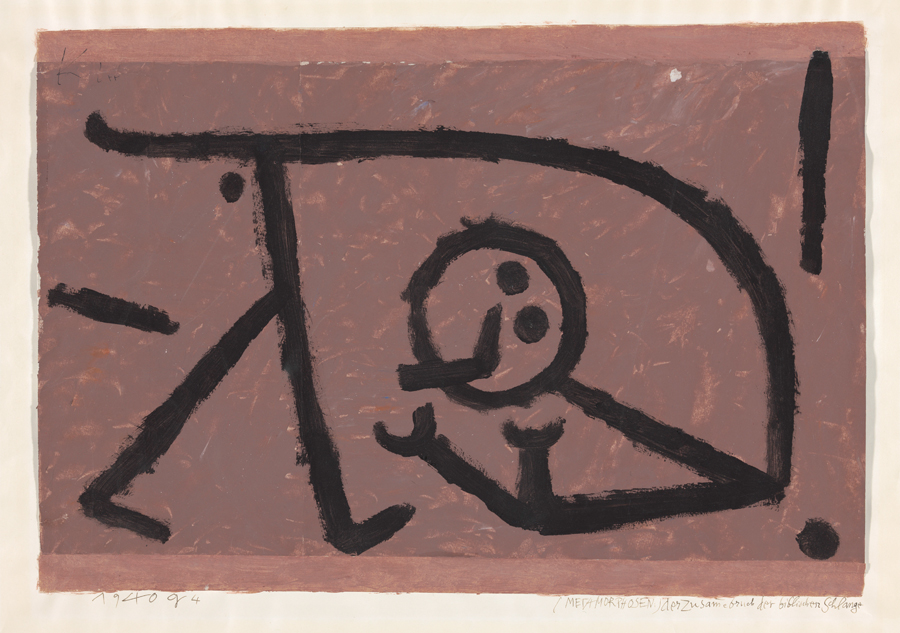Neolithic Childhood: Art in a False Present, c.1930
At Berlin’s Haus der Kulturen der Welt, an exhibition presents art from the turbulent interwar years as an archaeology of knowledge
At Berlin’s Haus der Kulturen der Welt, an exhibition presents art from the turbulent interwar years as an archaeology of knowledge

The neolithic, or new stone age, was the era of human history in which nomadic hunter-gathering gave way to sedentary farming with crops and livestock. The title of the exhibition ‘Neolithic Childhood. Art in a False Present, c.1930’, curated by Anselm Franke and Tom Holert, refers to a 1930 description of the artist Hans Arp. In an article titled ‘l’enfance néo-lithique’, published in Paris in Georges Bataille’s surrealist magazine Documents, the author and art historian Carl Einstein focused on playful and animistic aspects of Arp’s blending of the archaic and the modern. To Einstein’s encyclopaedic thinking, the artist’s wood and string reliefs relate to prehistoric rites and destructive forms of children’s play. The exhibition’s title suggests a view of the art and culture of the interwar years in terms of an archaeology of knowledge, using Einstein’s work as a lens. This era experienced a blooming of art and culture on the one hand and political and economic crises on the other: the high numbers of unemployment and the rise of right-wing and nationalist movements across Europe that led Freud to write, in 1930, Civilization and its Discontents.
The curators have brought together around 180 artworks and 600 archival objects. Rather than offering a direct biographical narrative about Einstein, the show tries (insofar as it is possible within an exhibition display) to render visible the fascinating world underpinning the period’s artistic and intellectual discourse. The resulting panorama – or, should we say, epistemic landscape – includes works by Willi Baumeister, Georges Braque, Maya Deren, Max Ernst, Hannah Höch, Paul Klee, André Masson and Kalifala Sidibé, among others.

Stretching over two halls, the show’s first chapter is formed around Einstein’s most important intellectual project: his plans for a five-volume ‘Handbuch der Kunst’ (Manual of art), worked on from 1935 and unfinished by the time of his death in 1940. A prominent place is given to the draft of 47 typewritten pages, mounted on a blue wall and accessible only via a low yellow metal platform. It is surrounded by a dozen vitrines, packed with books and printed matter representing the art publishing of that era: from magazines such as Weltkunst, founded in 1930 in Berlin, to art-historical encyclopaedias like the famous ‘Propyläen Kunstgeschichte’, first published in 28 volumes between 1923 and 1940. In 1926, Einstein’s polemic study Kunst des 20. Jahrhunderts (Art of the 20th Century) was published as the series’ 16th volume. Since the 1920s, the introduction of new offset printing techniques paved the way for mass-circulated, lavishly illustrated book series, effectively widening art-historical discourse to a global dimension at a time when interest in non-European art also flourished.

The second part of the exhibition presents the ways in which the arts and sciences, from the 1920s to the ’40s, responded to the collapse of traditional dualistic constellations: subject and object, nature and culture, female and male. Here, most of the paintings and drawings are displayed in a salon-style hang on a freestanding green wall. Its upper part can be viewed from a pedestrian overpass. Standing on the construction, you can see, at a slight distance, the drawing Metamorphosen: Der Zusammenbruch der biblischen Schlange (Metamorphoses: the Collapse of the Biblical Serpent, 1940) by Paul Klee, of whom Einstein once wrote: ‘one of the important features of [Klee’s] pictures seems to be: to free ourselves from the imposed body standard.’ Beside it are Jindřich Štyrský’s painting of a mysterious life form, L’Homme seiche (Human Cuttlefish, 1934), and Alexandra Povòrina’s spiritualistic painting Ying & Yang (1933). The overpass construction triggered a rather conflicting experience, somewhat like being on a fenced trail in a nature conservation area. The possibilities may be rich, but leaving the trail and getting lost are not part of the programme.
Translated by Nicholas Grindell
Neolithic Childhood. Art in a False Present, c. 1930, was on view at Haus der Kulturen der Welt, Berlin from 13 April until 9 July 2018.
Main image: Paule Vézelay, Drapeaux d'Hiver (detail), 1930, oil on canvas 97 × 146 cm. Courtesy: © Estate of Paule Vézelay; photograph: England & Co. Gallery, London























